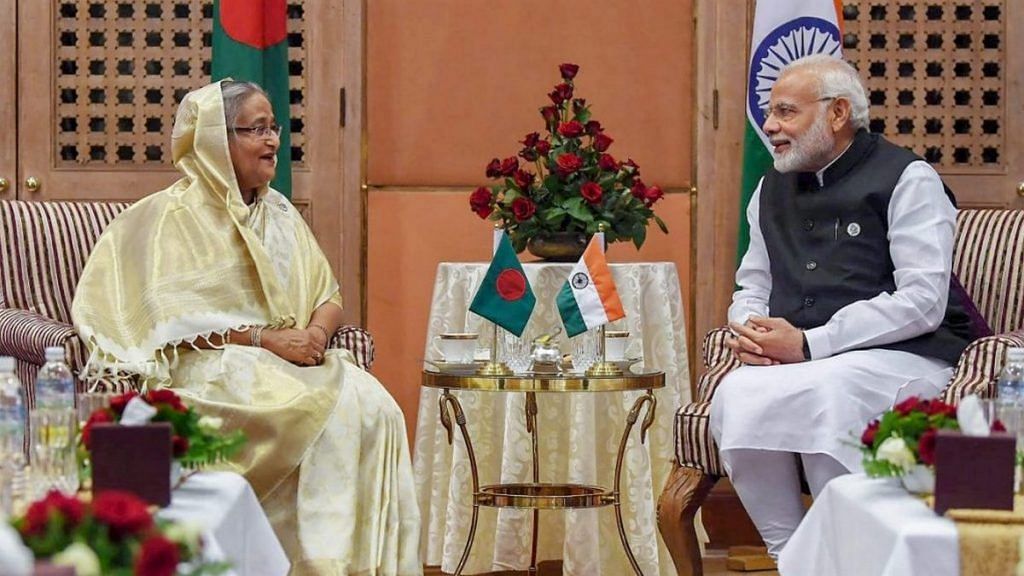Bangladesh Prime Minister Sheikh Hasina has arrived in Delhi for a four-day visit during which she will clock her 13th meeting with Prime Minister Narendra Modi, discuss defence and security issues, water-sharing and a likely economic partnership with the Indian leadership as well as book-end her trip with prayers at the shrines of the Sufi saints Nizamuddin Auliya in Delhi and Moinuddin Chishti in Ajmer Sharif.
But all this diplomatic jargon fades into the background if you cannot see the wood from the trees and the actual significance of Hasina’s visit. For the first time since the 1965 India-Pakistan War, a Bangladeshi prime minister has become instrumental in the restoration of economic connectivity across the entire Northeast of the Indian subcontinent.
Call it the second economic reunification of the region – not just of Bengal, which Lord Curzon was forced to do 110 years ago. What Hasina is doing today is remarkable not just because it’s never been done in the last 50 years since Bangladesh broke away from Pakistan and became an independent country — her decision to mend, rejoin, and restitch railway lines, road access, connections between inland waterways and dry ports across the Northeast is significant. These fell into active disuse after the 1965 War that Pakistan lost to India. What Hasina is doing today is dismantling the rigid Chinese wall that sprouted between the two neighbours 57 long years ago.
And she is doing much, much more. Hasina is also allowing the creation of brand-new connectivity links between India and India – let me explain.
A ‘choked’ Chicken’s Neck
The eight sister states – Assam, Meghalaya, Tripura, Arunachal Pradesh, Manipur, Nagaland, Sikkim, and Mizoram – of the Northeast are connected with the rest of India via a mere 22 km-wide sliver called the Chicken’s Neck. It significantly pushes up the cost of goods that reach the region; every Indian government worth its salt has beseeched Bangladesh to allow transit and trade across its territory. So far, every request has come a cropper.
But Hasina made the strategic decision some time ago that despite her unhappiness with the Modi government’s treatment of Muslims at home, of the fact that Delhi undermined her idea of the secular State by seeking out persecuted Hindu minorities in Bangladesh and offering them visas to India, and despite China offering attractive economic alternatives to the Indian model, her lot – and Bangladesh’s destiny – remains with India.
Hasina told ANI in a pre-visit interview that Bangladesh’s foreign policy is run according to the proverb “friendship to all, malice to none” — she understands the current differences of opinion between India and China, but doesn’t want to put her “nose on that”. Clearly, Hasina understands that even though China is, by far, the richer State, which is why Bangladesh is a member of the Belt and Road Initiative, India is the more intimate neighbour.
Here’s a snapshot of how railway tracks, roads, and boats have begun to criss-cross between the Indian mainland, Bangladesh, and the Indian Northeast in recent years.
A trial run of transhipment of Indian goods from Kolkata in West Bengal to Agartala in Tripura via Chittagong in Bangladesh took place in July 2020 – just as the fallout of Covid was bringing the house down in the subcontinent. The Mitali Express train from Jalpaiguri in West Bengal to Dhaka was restarted for the first time after 1965. The dredging of Bangladesh’s inland waterways has begun so as to smoothen the passage of Indian goods. The joint construction of the rail link between Agartala and Akhaura, just on the other side of Bangladesh, is ongoing as is the construction of the India-Bangladesh Friendship Pipeline.
Also read: If India allowed Teesta to flow, it would have got Hilsa, says Bangladesh PM Sheikh Hasina
Deepening India-Bangladesh ties
What is truly staggering is the recent cooperation in the movement of energy products from one part of Bangladesh to another – all because Hasina ordered this be done.
So, less than a fortnight ago, Bangladesh, under the bilateral transit protocol, allowed 10 Indian tankers of fuel oil to enter its territory from Meghalaya and exit into Tripura. On the afternoon of 25 August, the Indian tankers left Meghalaya’s Dauki land port and arrived at Sylhet’s Tamabil port. They completed all customs and immigration formalities and left Tamabil port at 4:30 pm. Then they further drove to the Chatlapur land customs station at Moulvibazaar, still in Bangladesh, reaching there at 9:30 pm. The 10 tankers completed all the exit formalities and crossed the border back into India, entering Kailashahar in Tripura at the Manu land customs station at 10:30 pm.
It was a seamless and historic move. Three of the 10 tankers were carrying 21.19 metric tonnes of Liquefied Petroleum Gas (LPG), and the remaining seven were carrying 83 metric tonnes of petroleum oil.
The importance of this recent movement of oil goods cannot be overestimated. Especially under current critical conditions, when the war in Ukraine is destabilising energy markets worldwide, the financial savings involved in moving essentials from one part of the country to another – from India to India – is incredible.
That’s why Sheikh Hasina is taking a deep breath on deepening ties with India. She also knows and understands well that this forging has benefits for both sides — she will need India’s understanding when elections are held in late 2023 and she tries to further decimate the Bangladesh Nationalist Party (BNP) and its informal ally, the pro-Pakistan Jamaat-e-Islami.
If she wins again, she will become prime minister for an unprecedented fifth time – whether or not the BNP participates in the election like it has refused to do the previous two times.
India’s leadership clearly sees the importance of Sheikh Hasina. Bangladesh’s most powerful person reciprocates the interest. The India-Bangladesh relationship is turning out to be a win-win relationship for both.
The author is a consulting editor. She tweets @jomalhotra. Views are personal.
(Edited by Humra Laeeq)
